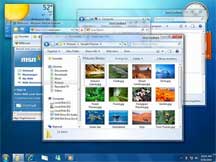|
| |
Master your Windows 7
desktop
Computer Main page|
Free weekly downloads|
Twitter |
Printer drivers|
Antivirus |
Children safety |
SMS|
Articles

Washington, (DPA) Who's in
control of your Windows 7 desktop - you or the operating
system?
With
applications and icons scattered all over the place,
constant pop-up notifications, and programmes hidden
deep within the Start menu, you might feel like
Microsoft has done its best to hinder your productivity
rather than enhance it.
But with a
little know-how and a few free tools, you can take
charge of your desktop like never before.
Use your
Windows computer long enough, and sometime during the
day you'll find you have a plethora of open
applications. Getting back to a clean desktop within
nothing running can involve dozens of clicks - and lots
of wasted time. There has to be a better way, right?
There is,
but Microsoft didn't provide it. Ntwind Software's free
tool CloseAll does pretty much what its name implies:
with one click, it closes every application running on
your desktop. The tool requires no installation.
Just
download it, unzip it in a folder of your choice, and
then create a shortcut to the exe file on your desktop.
You can also pin it to your taskbar for even easier
access. Its icon - a big red X - makes its intent
obvious. It's one of those little tools that you'll
wonder how Microsoft forgot.
When you're
trying to concentrate on an urgent report or
presentation, the last thing you need from your Windows
desktop is a distracting pop-up from the system tray,
telling you of some software update that can certainly
wait.
You can get
rid of those pop-ups for good in Windows 7, or you can
customise the desktop to show only those pop-ups that
you deem worthy.
First,
visit the Action Centre by opening the Start menu and
typing 'Action'. Click the first entry that appears,
which should be Action Centre.
From the
left-hand panel of the Action Centre, click 'Change
Action Centre settings', and you'll be taken to a dialog
box in which you can deselect a number of types of
system messages, including Windows Update notices,
backup reminders, or internet security settings.
Turn them
all off if you want to be left in peace. Click OK to
make your selections stick.
That will
take care of notifications from Windows, but to control
notifications from installed applications, you'll need
to open the Start menu and type 'Notifications'. Click
the resulting Notification Area Icons entry, which will
open a dialog box of the same name.
There, you
can see and control the 'behaviours' of each of the
system tray icons currently installed on your PC. Use
the Behaviours drop-down to tell Windows whether to hide
or show notifications from each icon, and click OK when
you're done.
Window 7
comes with dozens of keyboard shortcuts that let you
take control of your desktop quickly. Many of these
keyboard shortcuts use the Windows key - which has a
Windows logo on it along with the word Start on some
keyboards. We'll abbreviate that key simply with the
designation 'Win'.
Win+D, for
example - which means holding down the Windows key and
tapping the letter D - will quickly minimise all open
applications, leaving an empty desktop.
Pressing
Win+D again will reopen the applications to the state
they were in before. Win+T cycles through the thumbnails
in your Windows taskbar. It's the same as rolling your
mouse cursor over the icons in the taskbar.
Hold down
the Windows key and tap the plus key on your number pad
to magnify the open documents on your desktop. This is a
great trick for reading fine print. The Windows key plus
the minus key on your keypad zooms you back out.
Sometimes
controlling your desktop is about finding ways to call
up applications quickly or power through ones that are
already running. For these jobs, it's tough to find
better tools than Hotkeyz and Switcher.
Hotkeyz
lets you start an application or execute a series of
commands with a key combination of your choice. Switcher
displays large thumbnails of all of your running
applications across your entire desktop, making it easy
to find just the programme you're looking for from among
the many that might be running on your PC.
Courtesy:
IANS / Yahoo News
| |
|



